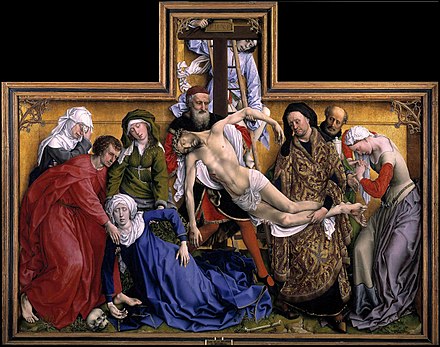More about The Descent from the Cross
- All
- Info
- Shop

Contributor
How many people can say they've made someone as famous as the Michelangelo cry like a little girl? Rogier van der Weyden might just top the short list.
Lots of artists paint super emo scenes…like REAL tearjerkers (think Toni Braxton on canvas meets the closing scene of Titanic), but to make a bigshot like Michelangelo go misty-eyed? That's pretty impressive.
Flemish painter Rogier van der Weyden’s Descent from the Cross is more than likely one of the paintings that Michelangelo had in mind when he famously said: “Flemish painting [will] please the devout better than any painting of Italy, which will never cause him to shed a tear, whereas that of Flanders will cause him to shed many.” Someone pass this guy a Kleenex.
Indeed, the sorrowful tones in Weyden’s painting are fully wailing out to the audience. The tragic death of Jesus Christ, for one, is a major bummer. So much so that the ashen-faced Virgin Mary has collapsed to the ground with grief, in a pose that is famously known as “the Swoon of the Virgin”. The nun-like lady in the back (far left) and the guy in the gold and black brocade lifting Christ’s legs are also look pretty messed up. Almost like super sad sculptures.
Also, the unusual shape of the canvas gives it the appearance of a tunneled out space being viewed in cross section—kind of like a crypt! Especially when you take into account the skull and random bones strewn across the ground.
This pathos producing painting was commissioned by the Archers guild of Louvain for the church of Notre-Dame-hors-le-murs, which means something like outside the walls of Notre Dame. In this central panel of a triptych, van der Weyden pays homage to the patrons with the little crossbows that lace the corners of the canvas. Decorative AND paying compliment! You go, Rogier.
Now excuse me while I listen to this Celine Dion song and weep myself gently to sleep.
Featured Content
Here is what Wikipedia says about The Descent from the Cross (van der Weyden)

The Descent from the Cross (or Deposition of Christ, or Descent of Christ from the Cross, or in Flemish Kruisafneming) is a panel painting by the Flemish artist Rogier van der Weyden created c. 1435, now in the Museo del Prado, Madrid. The crucified Christ is lowered from the cross, his lifeless body held by Joseph of Arimathea and Nicodemus.
The c. 1435 date is estimated based on the work's style, and because the artist acquired wealth and renown around this time, most likely from the prestige this masterwork brought him. It was painted early in his career, shortly after he completed his apprenticeship with Robert Campin and shows the older painter's influence, most notable in the hard sculpted surfaces, realistic facial features and vivid primary colours, mostly reds, whites and blues. The work was a self-conscious attempt by van der Weyden to create a masterpiece that would establish an international reputation. Van der Weyden positioned Christ's body in the T-shape of a crossbow to reflect the commission from the Leuven guild of archers (Schutterij) for their chapel Onze-Lieve-Vrouw-van-Ginderbuiten (Notre-Dame-hors-les-Murs).
Art historians have commented that this work was arguably the most influential Netherlandish painting of Christ's crucifixion, and that it was copied and adapted on a large scale in the two centuries after its completion. The emotional impact of the weeping mourners grieving over Christ's body, and the subtle depiction of space in van der Weyden's work have generated extensive critical comments, one of the most famous being, that of Erwin Panofsky: "It may be said that the painted tear, a shining pearl born of the strongest emotion, epitomizes that which Italian most admired in Early Flemish painting: pictorial brilliance and sentiment".
Check out the full Wikipedia article about The Descent from the Cross (van der Weyden)
















